Beetal Goat Breed
Comprehensive guide to one of Punjab’s most productive dual-purpose goat breeds, known for excellent milk production and meat quality across North India.
Beetal Breed Statistics
Key performance indicators and breed characteristics of Beetal goats in Indian farming conditions
Complete Beetal Goat Information
Origin and History
Beetal goats originated in the Punjab region, particularly around Batala tehsil. This dual-purpose breed has been selectively bred by farmers for over centuries, developing excellent milk production capabilities alongside good meat quality.
Physical Characteristics
Large-sized goats with long, pendulous ears measuring 25-30 cm. Coat colors vary from light brown to dark brown, often with white patches. Males have prominent beards and twisted horns.
Body Measurements
Adult males weigh 75-90 kg while females range 50-65 kg. Body length averages 75-85 cm with height at withers measuring 85-95 cm for males and 75-85 cm for females.
Breed Recognition
Officially recognized by the National Bureau of Animal Genetic Resources (NBAGR) and listed in the breed registry. Popular across Punjab, Haryana, Delhi, and parts of Uttar Pradesh.
Milk Production
Average daily milk yield ranges 2-3 liters with peak production reaching 4 liters in optimal conditions. Lactation period extends 6-8 months with annual milk production of 400-600 liters.
Reproductive Performance
Sexual maturity achieved at 12-15 months. Kidding interval averages 12 months with 1-3 kids per kidding. Twin births are common, contributing to good reproductive efficiency.
Growth Rates
Kids achieve 12-15 kg weight at 6 months with daily weight gain of 80-120 grams under proper nutrition. Adult weight reached by 18-24 months of age.
Meat Quality
Excellent meat production with good marbling and taste. Dressing percentage ranges 45-50%. Castrated males can reach 70-80 kg live weight for meat production.
Feeding Requirements
Daily dry matter intake 3-4% of body weight. Requires good quality green fodder (8-10 kg), concentrate feed (300-500g), and clean drinking water (4-6 liters daily).
Housing Specifications
Minimum 15-20 sq ft per adult goat. Well-ventilated pucca or semi-pucca sheds with proper drainage. Separate housing for bucks, pregnant does, and kids recommended.
Health Management
Regular vaccination against PPR, FMD, and enterotoxemia. Deworming every 3-4 months. Common issues include pneumonia, diarrhea, and external parasites requiring prompt treatment.
Breeding Management
Maintain 1:25-30 buck to doe ratio. Practice controlled breeding for year-round kidding. Genetic improvement through artificial insemination available in progressive areas.
Geographic Distribution
Primarily found in Punjab (Gurdaspur, Amritsar, Batala districts), Haryana, Delhi, and western Uttar Pradesh. Well-adapted to Indo-Gangetic plain conditions.
Climate Adaptability
Thrives in semi-arid to humid subtropical climate. Tolerates temperature range of 5-45°C. Requires adequate shelter during extreme weather conditions.
Market Demand
High demand in North Indian markets for both milk and meat. Premium prices for breeding stock. Growing popularity in peri-urban dairy farming systems.
Conservation Status
Population stable with estimated 1.2 million animals. Active breeding programs by state animal husbandry departments and research institutions ensure genetic diversity.
Practical Farming Information
Evidence-based management practices for successful Beetal goat farming
Nutrition Management
- Green Fodder: Berseem, lucerne, jowar, maize – 8-10 kg daily
- Dry Fodder: Wheat straw, paddy straw – 1-2 kg daily
- Concentrate: 300-500g for milch animals, 200-300g for dry animals
- Minerals: 10-15g mineral mixture daily
- Water: Clean drinking water 4-6 liters daily
- Pregnancy: Additional 200g concentrate in last 6-8 weeks
Housing Requirements
- Space: 15-20 sq ft per adult, 10 sq ft per kid
- Ventilation: Cross ventilation with 1-2 feet clearance
- Flooring: Brick/concrete with slope for drainage
- Roof Height: 10-12 feet for proper air circulation
- Feeding Space: 18 inches per animal at feed manger
- Separate Areas: Buck house, maternity pen, sick animal isolation
Healthcare Protocol
- Vaccination: PPR (annually), FMD (bi-annually), ET (annually)
- Deworming: Every 3-4 months or as per FEC
- Hoof Trimming: Every 6 months or as needed
- Body Condition: Monthly scoring and weight monitoring
- Common Diseases: Monitor for pneumonia, diarrhea, mastitis
- Veterinary Care: Regular health check-ups every 6 months
Breeding Management
- Age at Breeding: 12-15 months or 30-35 kg body weight
- Estrus Cycle: 18-21 days with 24-48 hours heat period
- Gestation Period: 145-155 days (average 150 days)
- Buck Selection: Good conformation, disease-free, proven genetics
- Breeding Records: Maintain detailed breeding and production records
- Kidding Care: Clean environment, colostrum within 1 hour
Beetal vs Other Breeds Comparison
| Parameter | Beetal | Jamunapari | Barbari | Sirohi |
|---|---|---|---|---|
| Body Weight (Male) | 75-90 kg | 65-90 kg | 35-45 kg | 50-65 kg |
| Body Weight (Female) | 50-65 kg | 40-60 kg | 25-30 kg | 35-45 kg |
| Daily Milk Yield | 2-3 liters | 2-3 liters | 1-2 liters | 1.5-2 liters |
| Lactation Period | 6-8 months | 7-9 months | 5-6 months | 6-7 months |
| Kids per Kidding | 1-3 | 1-2 | 2-3 | 1-2 |
| Primary Region | Punjab, Haryana | Uttar Pradesh | Uttar Pradesh | Rajasthan |
Start Your Beetal Goat Farm
Begin your journey in profitable goat farming with comprehensive breed information and expert guidance


